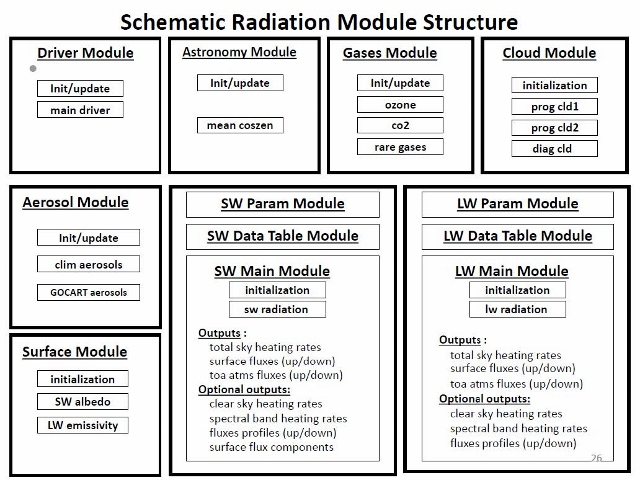Radiative processes are among the most complex and computationally intensive parts of all model physics. As an essential component of modeling the atmosphere, radiation directly and indirectly connects all physics processes with model dynamics, and it regulates the overall earth-atmosphere energy exchanges and transformations.
The schematic radiation module structure is shown in Figure 1.

GFS radiation package is intended to provide a fast and accurate method of determining the total radiative flux at any given location. These calculations provide both the total radiative flux at the ground surface, which is needed to establish the surface energy budget, and the vertical radiative flux divergence, which is used to calculate the radiative heating and cooling rates of a given atmospheric layer. The magnitude of the terms in the surface energy budget can set the stage for moist deep convection and are crucial to the formation of low-level clouds. In addition, the vertical radiative flux divergence can produce substantial cooling, particularly at the tops of clouds, which can have strong dynamical effects on cloud evolution.
Since 2007, the longwave (LW) and the shortwave (SW) radiation parameterizations in NCEP's operational GFS are both modified and optimized versions of the Rapid Radiative Transfer Model for GCMs (RRTMG_LW v2.3 and RRTMG_SW v2.3, respectively) developed at AER inc. (Atmospheric and Environmental Research) (Iacono et al.(2008) [91]; Mlawer et al.(1997) [125]; Iacono et al.(2000) [90]; Clough et al. 2005 [37]). The LW algorithm contains 140 unevenly distributed g-points (quadrature points) in 16 broad spectral bands, while the SW algorithm includes 112 g-points in 14 bands. In addition to the major atmospheric absorbing gases of ozone, water vapor, and carbon dioxide, the algorithm also includes various minor absorbing species such as methane, nitrous oxide, oxygen, and in the longwave up to four types of halocarbons (CFCs). To represent statistically the unresolved subgrid cloud variability when dealing multi layered clouds, a Monte-Carlo Independent Column Approximation (McICA) method is used in the RRTMG radiative transfer. A maximum-random cloud overlap method is used in both LW and SW radiation calculations.
Radiative fields from model outputs ( \(W m^{-2}\)) include: